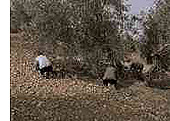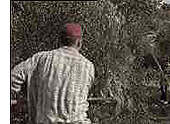|
• Picking off the ground
Farmers wait until the ripe fruit falls naturally off the tree, and the
olives are collected from the ground. This procedure may be repeated
later when more olives have fallen. This method is used in the case of
very large trees and when it is difficult to access the zone. Its major
disadvantage clearly lies in the quality of oil that is produced, with
low yield and therefore high labour costs.
•
Ordeņo (by hand)
This is by far the most commonly used
method in picking table olives. The labourer stands up on a ladder or
reaches up from the ground to pick the olives by hand and drop them into
a bag hanging around his neck. In the case of olives that are to be made
into oil, the procedure is simplified, and here the labourer runs his
hand along the olive-loaded branches, and the olives fall onto canvas
sheets laid out underneath the tree.
•
Vareo (beating)
(beating)
This is the most commonly used method in the fields. The
labourer beats the branches with a three or four metre long
pole in a crossways motion in order not to damage the tree.
The olives are collected in canvas sheets or nets that are
spread out over an area that amply covers the size of the
tree. The sheets are then folded up and their contents are
tipped into baskets or sacks.
Knocking the olives down is the procedure that has undergone
the biggest development in mechanisation, and where there is
the greatest focus on speeding up the labourer’s work and
making it less awkward. This is why engineers are insisting
on developing machines that will meet the needs of workers
at this preliminary stage.
|
